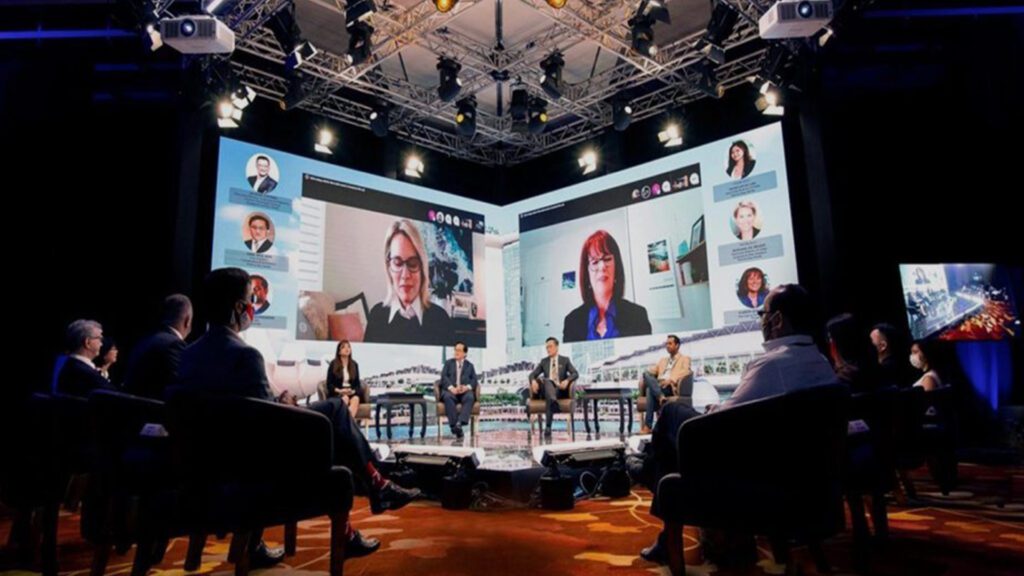In the last few years, the world has witnessed a spectacular shift in dynamics. Till a few months ago, we were sitting in the conference rooms of our office at 9 a.m. discussing company goals. As challenging as the shift has been, human beings have found a viable way of adapting to the next best alternative for survival.
During this time, Zoom may have been a household name as it enabled work meetings, but it also went on to bring your near and dear ones closer in this socially distant world. When everything is moving online, so too are physical events. Every year, organizations, irrespective of their size, be it small or big, have schedules in place on how to host a virtual event in order to achieve their desired goals.

What are virtual events?
Virtual events are held online. It depends on the performance, as it can be held in the form of invite-only webinars, informal social media events, publicly available live streams, or questions and answer sessions.
Virtual events take place on online platforms like Twitter, Instagram, or Club House, where you can connect with your audience on a video or audio call. The market is growing for specialized platforms as they provide input on how to host a virtual event with relative ease. One of the main benefits of holding a virtual event is that it is inexpensive, as there is no need to rent out space. From the comfort of your home, you can speak to a global audience.
Though there are some pointers to keep in mind when hosting virtual events as you are not physically present in front of your guests, Some of the participants may feel disconnected or find it difficult to figure out what you are saying due to poor audio and video quality, background noise, or soundproofing.
The types of virtual events
There is no set occasion or event where you can hold a virtual event; however, some of the more popular types of virtual events are listed below.
- Virtual team-building events: this form of event allows a participant to engage in a variety of team-building activities and enhances team morale. This can all be done from the comfort of their offices.
- Virtual networking activities: this event allows the attendees to come together and interact in a virtual environment. Numerous types of network events can be hosted, such as work get-togethers, happy hours, and more.
- Virtual fund-raising events: Once upon a time, it was difficult for a non-profit or a charitable organization to make their voice heard, but with technology advancements, virtual fund-raising has taken off big time. This turns out to be one of the popular methods of raising money online.
- Virtual shopping events: Experts are of the opinion that live-stream shopping is the next big thing in e-commerce and social media. Numerous virtual shopping events are held online where product demos are offered and attendees can shop virtually for any cosmetics, clothes, or other products.
- Virtual hiring events: a virtual hiring event provides a viable opportunity for narrowing down the talent pool and identifying qualified candidates. This means that the employees do not have to spend a lot of time or money recruiting capable candidates.

The Best practices when it comes to holding a virtual event
The question emerges of how to host a virtual event that provides a high-end digital experience with continuous engagement and a one-on-one experience. To understand this, let’s understand the dos and don’ts when you are holding a virtual event.
Decide on the type of event that you are planning to host
Before you begin, you need to have a clear picture of the goals that you are planning to achieve through a particular event. Whether it is a virtual career fair, a virtual conference, or any other event, you need to outline the objectives for the team to organize and configure their respective event.
For a virtual event, the choice of the right platform
When you are choosing a virtual events platform, ensure it complies with the necessary requirements to align with the mission and vision of your brand. A list of questions is to be prepared and inquired about until you are sold on the service. Some of the standard questions that can be asked related to a specific virtual event are
- The quality or number of design options
- The types of engagement tools on offer
- Any affiliations or third-party plug-ins
- The types of accessibility features that are available
- The level of customer support that caters to your time zone
A realistic timeline is to be developed
It takes around 8 to 10 weeks for an event to be up and running. But if you have decided on how to host a virtual event, it is better to book the day in advance so that you can develop it to perfection and have enough time to cater to your audience.
With a virtual event, an immersive experience is to be provided
There is a saying that says not to judge a book by its cover, and this point substantiates this. All of us are aware of what to expect the moment we head to a physical event. When it comes to a virtual event, a user interface places great emphasis on attendees. It all starts with the landing page, where visitors form their first impression and decide whether or not to continue.
To encourage maximum sign-ups, the design has to be captivating. As part of an event, it is critical to ensure that the environment replicates or comes close to replicating the live experience of an in-person event.
Publicity via social media
Social media is built for a reason. It is the right time to make use of the social media platforms like Twitter, Facebook, Instagram, etc. that you find your audience engaging with to increase registrations and market an event.
Making use of engagement tools
The rate of engagement determines the success of an event. For group discussions or one-on-one interaction, it is better to use live chat tools in combination with polls and surveys to ensure that visitors can interact smoothly with exhibitors. It could be job seekers in the case of real-time jobs or career fairs.
Live webinars will be hosted and keynotes will be delivered
For addressing the masses, webinars turn out to be the most effective tool. Keynote speakers can be invited from various parts of the globe, and normally you would have to bear extra accommodation and travel expenses. Based on their respective availability, you can book their time slots, and a question-and-answer session paves the way for two-way communication. This would generate feedback from the audience.
Quality content is to be made available
Regardless of how to host a virtual event, content plays an important role. It can be in the form of videos, documents, or presentations. The content will be the voice of your brand during a virtual event.

Gamify the event
By gamifying the event, you can incentivize certain steps that you wish your audience to complete. Leader boards increase the time that your audience spends at an event, which is going to leave a lasting impression on your audience and enhance the quality of leads.
Advanced branding and providing configurable booths
The exhibitors should be able to showcase their brands with a variety of booth designs that depict unique personalities.
The sponsors need to hog the limelight
The sponsors need to be given a dedicated area where they can showcase themselves, just as is the case with a physical event. A number of options can be used to display brand logos, sessions, or content in a virtual environment. The impact would be the same as an in-person fair.
Detailed reports are to be generated
Detail reports are a key feature that distinguishes a virtual event from a physical event. Ascertain that registrations can be added to the CRM or mailing lists for lead generation purposes. Apart from that, content insights and engagement can enable you to measure your KPIs and ROI.
To sum things up, While the idea of how to host a virtual event may seem overwhelming for many businesses, a majority of organizations have been able to come out stronger by hosting virtual events. With the right set of objectives and the right virtual provider, achieving exceptional results turns out to be one of the realistic aims for your business in the present year.
For more such blogs, Connect with GTECH.
Related Post
Publications, Insights & News from GTECH








